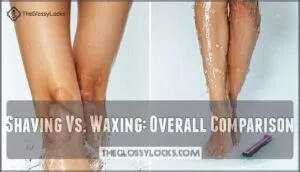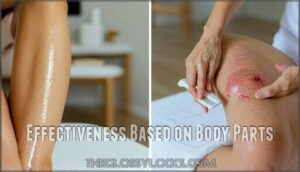This site is supported by our readers. We may earn a commission, at no cost to you, if you purchase through links.

Waxing lasts longer – typically 3-6 weeks versus shaving’s few days – but it’s more painful and expensive upfront.
You’ll deal with temporary redness and potential ingrown hairs with both methods.
Shaving offers quick, painless convenience but requires frequent touch-ups.
Your skin type, pain tolerance, and budget play key roles in this choice.
Some women prefer waxing for special occasions and shaving for daily maintenance.
The real game-changer lies in understanding which method works best for different body parts and your unique lifestyle demands.
This choice is highly dependent on what works best for your unique situation, considering personal needs.
Table Of Contents
- Key Takeaways
- Is Waxing Better Than Shaving for Women?
- Shaving Vs. Waxing: Overall Comparison
- Effectiveness Based on Body Parts
- Health Considerations: Skin Sensitivity
- Health Considerations: Medication and Personal History
- Pain Tolerance Level
- Time Frame: Short-Term Vs. Long-Term Results
- Preparing Your Skin: Waxing
- Post-Waxing Skin Care Tips
- Preparing Your Skin: Shaving
- Post-Shaving Skin Care Tips
- Frequently Asked Questions (FAQs)
- Is waxing or shaving better for girls?
- What is healthier, waxing or shaving?
- Is it better to wax or shave a woman’s face?
- Is it healthy to wax pubic hair female?
- What method is best for precision areas?
- How often should I wax/shave?
- Can I wax/shave if I have sensitive skin?
- How long does hair need to be for waxing?
- What are the risks of waxing/shaving?
- How much does professional waxing typically cost?
- Conclusion
Key Takeaways
- Your choice between waxing and shaving depends on your priorities: waxing lasts 3-6 weeks but costs more and hurts, while shaving is quick and painless but requires daily maintenance.
- You’ll get better results by matching the method to your body part – waxing works best for precision areas like bikini lines and eyebrows, while shaving is ideal for legs and daily touch-ups.
- Your skin sensitivity and medical history matter more than you think – if you’re on blood thinners or retinoids, or have conditions like eczema, you’ll need to adjust your approach or avoid certain methods entirely.
- You can minimize problems with either method through proper prep and aftercare – exfoliate before waxing, use sharp razors for shaving, and moisturize afterward to prevent ingrown hairs and irritation.
Is Waxing Better Than Shaving for Women?
The hair removal debate between waxing and shaving isn’t one-size-fits-all.
Your choice depends on priorities like cost comparison, pain management, and convenience factor.
**Your beauty routine should work for you, not against you – choose what fits your lifestyle and comfort level.
Waxing delivers longer-lasting results with superior skin exfoliation, but comes with higher costs and discomfort.
Shaving offers instant gratification and budget-friendly convenience, though hair regrowth happens within days.
This hair removal comparison reveals that waxing benefits include weeks of smooth skin, while shaving benefits center on quick, painless maintenance.
Understanding these hair removal methods helps you choose what fits your lifestyle, pain tolerance, and budget best.
Shaving Vs. Waxing: Overall Comparison
Choosing between hair removal methods requires understanding key differences. Your decision depends on cost comparison, convenience, and personal preferences.
| Factor | Waxing | Shaving |
|---|---|---|
| Pain levels | Moderate to high | Minimal |
| Duration | 3-4 weeks | 1-3 days |
| Cost | Higher upfront | Lower ongoing |
Waxing benefits include longer-lasting results and hair reduction over time. The process provides skin exfoliation, removing dead cells while pulling hair from roots. Regrowth texture becomes finer with repeated sessions.
Shaving benefits focus on convenience and speed. You’ll spend less money initially, though razor refills add up. It’s painless but requires daily maintenance.
Hair removal methods differ in technique too. Waxing needs hair length of at least 6mm, while shaving works on any length. Your hair removal comparison should weigh these practical considerations against your lifestyle needs.
Effectiveness Based on Body Parts
Different body parts respond uniquely to waxing vs shaving methods. Your choice depends on the specific area you’re targeting and your personal priorities.
Here’s how effectiveness varies by body part:
- Legs versus Arms – Shaving works well for quick daily maintenance, while waxing provides 3-4 weeks of smoothness and reduces hair density over time.
- Bikini Line – Waxing offers precise shaping and longer-lasting results, though shaving allows better control for sensitive skin.
- Underarms – Waxing reduces hair thickness with repeated sessions, but shaving remains faster for daily routines.
- Facial Hair – Waxing excels for eyebrows and upper lip precision, while shaving can cause stubble issues.
- Back Hair – Professional waxing proves more practical than attempting to shave hard-to-reach areas yourself.
Waxing removes hair from the root, targeting anagen phase hair, resulting in longer-lasting smoothness.
Health Considerations: Skin Sensitivity
Your skin’s sensitivity level affects how well you’ll handle different hair removal methods.
Your skin’s unique needs should guide your hair removal choice, not popular trends or peer pressure.
If you have sensitive skin, you’re more likely to experience redness, irritation, or bumps with both waxing and shaving, but the type and severity of reactions can vary between these methods.
Waxing Irritation
Post-waxing skin reactions can catch you off guard, but understanding these waxing side effects helps you stay prepared.
Your skin faces several potential challenges after hair removal that require attention and proper aftercare products.
Here are the main waxing irritation concerns to watch for:
- Waxing Rash and Redness: Temporary inflammation occurs as your follicles recover from hair removal, typically lasting 24-48 hours.
- Allergic Reactions: Some people develop sensitivity to wax ingredients or aftercare products, so patch testing prevents unwanted surprises.
- Infection Prevention: Poor hygiene during or after waxing creates scarring risks and bacterial problems that proper aftercare can eliminate.
Understanding these waxing vs shaving differences helps you make informed decisions about skin irritation management.
Shaving Cuts
When razor meets skin, sharp, clean blades are your best defense against cuts and nicks.
Dull blades drag across your skin, creating more friction and increasing your infection risk.
Quality razor types make a difference – disposable razors often cause more problems than they solve.
Shaving technique matters too.
Light pressure and proper angles prevent most shaving side effects.
If you’re constantly battling cuts, consider switching methods entirely.
| Cut Prevention | Aftercare Routine |
|---|---|
| Use sharp razors | Clean cuts immediately |
| Apply light pressure | Apply antiseptic |
| Proper blade angle | Monitor for infection |
| Quality shaving cream | Keep wounds dry |
Shaving irritation and razor burn from poor technique can leave you dealing with shaving pros and cons that tip toward the negative side.
Skin Sensitivity
Your sensitive skin doesn’t have to call the shots when choosing between waxing and shaving. Understanding your skin’s unique needs helps you make the right choice for your body.
Sensitive skin responds differently to each method. Waxing can trigger allergic reactions to wax product ingredients like rosin or fragrances. Shaving may cause less immediate trauma but can lead to razor burn with repeated use.
Consider these factors for irritation prevention:
- Test patch areas before full treatment to check for reactions
- Choose fragrance-free products to minimize sensitivity triggers
- Follow proper post-procedure care regardless of your chosen method
Waxing for sensitive skin requires extra caution, while shaving offers more control over pressure and technique. Both waxing pros and cons and shaving pros and cons include skin sensitivity considerations that affect your comfort level.
Health Considerations: Medication and Personal History
Your medical history plays a big role in choosing between waxing vs shaving for women.
Blood thinners increase bruising risk during waxing, while retinol medications make skin ultra-sensitive.
Pregnancy concerns include hormonal changes affecting skin reactions.
Always disclose your allergy history and current medications to technicians.
Some skin conditions like eczema require complete healing before waxing for women becomes safe.
Certain medications, like those that accelerate skin exfoliation, can increase the risk of skin lifting during waxing, which is a significant consideration for women with sensitive skin or specific medical conditions.
Pain Tolerance Level
Your pain threshold plays a huge role in choosing between waxing vs shaving.
Waxing for women involves pulling hair from the root, creating moderate to intense discomfort.
Waxing pain level varies by body area – underarms rate 2-3/10 while bikini zones feel more intense.
Individual sensitivity differs dramatically between people.
Some find waxing pain decreases with regular sessions as follicles weaken.
Shaving for women offers virtually painless hair removal.
The shaving sensation feels like a light tickle with minimal discomfort.
Occasional nicks might sting briefly, but nothing compared to waxing’s intensity.
Discomfort management matters for waxing – numbing creams and pain medication help.
If you can’t handle moderate pain, shaving provides comfortable results without the tears.
Time Frame: Short-Term Vs. Long-Term Results
Choosing between waxing vs shaving depends on your time preferences and maintenance goals.
Shaving delivers instant results but requires daily upkeep as hair regrowth appears within 1-3 days.
Waxing offers longlasting hair removal, keeping you smooth for 3-6 weeks with slower hair growth rate and finer hair texture over time.
| Aspect | Shaving | Waxing |
|---|---|---|
| Regrowth Speed | 1-3 days | 3-6 weeks |
| Maintenance Frequency | Daily | Monthly |
| Long-Term Costs | Ongoing razors/creams | Higher upfront, less frequent |
| Hair Reduction | No change | Gradual thinning |
Preparing Your Skin: Waxing
Proper waxing preparation sets the stage for smooth, comfortable hair removal. Your skin needs attention before that first strip comes off.
Follow these essential preparation steps:
- Exfoliation Importance: Gently scrub skin 24-48 hours before waxing to prevent ingrown hairs
- Hair Length: Verify hair measures ¼ to ½ inch long for ideal grip
- Skin Cleansing: Clean the area thoroughly with antibacterial soap before starting
- Hydration Levels: Moisturize daily leading up to your appointment, but skip lotion on waxing day
- Temperature Control: Test wax warmth on your wrist first to avoid burns
Smart waxing preparation makes all the difference. A quality waxing scrub can improve results.
Post-Waxing Skin Care Tips
Fresh waxing leaves your skin feeling raw and vulnerable. Proper aftercare transforms potential irritation into smooth, glowing results.
Here’s your post-waxing recovery roadmap:
- Soothing Irritation – Apply cold aloe vera gel immediately to calm inflamed skin
- Hydration Importance – Use fragrance-free moisturizers twice daily for ideal skin care
- Exfoliation Timing – Wait 48 hours before gentle exfoliation to prevent ingrown hairs
- Sun Protection – Avoid direct sunlight for 24 hours; use SPF 30+ when outdoors
Consider using a specialized skin product for superior results. Your irritated skin needs gentle treatment, not harsh products that’ll make things worse.
Preparing Your Skin: Shaving
Smart skin-prep transforms your shaving process from a rushed chore into a smooth experience. Start with warm water to soften hair and open pores.
Choose quality shaving cream that creates a protective barrier between your razor and skin. Exfoliation importance can’t be overstated—gently scrub away dead cells beforehand to prevent ingrown hairs.
Razor type matters too; sharp, multi-blade options reduce passes needed. Hydration benefits include less friction and fewer nicks.
Many women find success using specialized shaving products. Technique matters most: never dry shave, as this guarantees razor burn and irritation, making hydration and proper technique crucial for a pleasant shaving experience with minimal friction.
Post-Shaving Skin Care Tips
After shaving, your skin needs attention to prevent razor burn and ingrown hairs. Smart aftercare keeps you comfortable and confident.
Follow these post-shaving essentials:
- Apply moisturizer immediately – Use fragrance-free lotions with aloe or glycerin for moisturizing after shave relief
- Prevent ingrown hairs – Gentle exfoliation 2-3 times weekly removes dead skin cells
- Soothe razor burn – Cold compresses and product ingredients like witch hazel calm irritation
- Skip tight clothes – Loose fabrics reduce friction on freshly shaved skin for better ingrown hair prevention
Frequently Asked Questions (FAQs)
Is waxing or shaving better for girls?
Both methods have trade-offs.
You’ll get longer-lasting results with waxing, but it’s more painful and expensive.
Shaving’s quicker and cheaper, though you’ll need to do it more frequently for smooth skin.
What is healthier, waxing or shaving?
Both methods have health trade-offs.
You’ll face irritation and ingrown hairs with either choice.
Waxing causes temporary inflammation but exfoliates skin.
Shaving risks cuts and razor burn but doesn’t pull hair from roots, which can be seen as a trade-offs in the context of hair removal methods.
Is it better to wax or shave a woman’s face?
Choosing between facial waxing and shaving depends on your priorities.
Waxing delivers longer-lasting results but causes more pain and irritation.
Shaving offers gentler, convenient daily maintenance but requires frequent touch-ups for smooth skin.
Is it healthy to wax pubic hair female?
Waxing your pubic hair is generally healthy when done properly.
You’ll experience longer-lasting results and reduced ingrown hairs compared to shaving.
However, temporary redness and minor irritation are normal post-wax reactions, which can be considered a normal part of the process.
What method is best for precision areas?
For precision areas like eyebrows, upper lip, or bikini line, you’ll want waxing.
It targets hair at the root with exact control, letting you shape and define small spaces that razors can’t navigate effectively.
How often should I wax/shave?
Like clockwork, your hair follows its own rhythm.
You’ll need to shave every two to three days for smooth skin.
Waxing lasts three to six weeks since it removes hair from the root completely.
Can I wax/shave if I have sensitive skin?
You can wax or shave with sensitive skin, but take extra precautions.
Test on a small area first, use gentle products, avoid irritated skin, and consider professional waxing for better technique and reduced irritation.
How long does hair need to be for waxing?
Here’s the golden rule you can’t ignore: your hair must be at least ¼ inch long before waxing.
That’s roughly 6mm or about three weeks of growth after shaving for effective removal.
What are the risks of waxing/shaving?
You’ll face different risks with each method.
Waxing can cause pain, redness, bumps, and infections, especially on sensitive skin.
Shaving risks include razor burn, cuts, irritation, and ingrown hairs from frequent use.
How much does professional waxing typically cost?
Professional waxing costs vary by location and body area. You’ll typically pay $20-50 for small areas like eyebrows or upper lip, while full-body sessions range from $152-280 at most salons.
Conclusion
Like choosing between sneakers and heels, deciding if waxing is better than shaving for women depends on your specific needs.
Consider your pain tolerance, budget, and time availability.
Waxing works best for long-term smoothness and special events, while shaving suits daily routines and sensitive skin.
Your lifestyle, body parts being treated, and skin sensitivity should guide your decision.
Both methods have benefits and drawbacks.
Test both approaches to determine which fits your personal preferences and circumstances best, considering what works for your daily routines.
- https://my.clevelandclinic.org/health/body/23435-hair-follicle
- https://foxyboxwaxbar.com/foxy-news/how-long-does-waxing-last/
- https://pubmed.ncbi.nlm.nih.gov/28079638/
- https://www.styleseat.com/blog/waxing-cost/
- https://click.linksynergy.com/deeplink?id=xU%2AITpjPkO4&mid=35269&u1=womanandhome-us-5440747133015975833&murl=https%3A%2F%2Fwww.cultbeauty.co.uk%2Fdeodoc-shaving-intimate-foam%2F13419569.html%3Faffil%3Dthggpsad%26switchcurrency%3DGBP%26shippingcountry%3DGB%26affil%3Dthggps%26gclid%3DCj0KCQjwjN-SBhCkARIsACsrBz4bvRcFhEO_KlPSHUMNlc-p4zbsBOFFnvmoJ5KTlrK9DPDwmQ-uay8aAuyJEALw_wcB%26gclsrc%3Daw.ds











